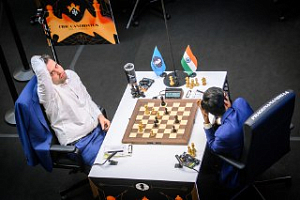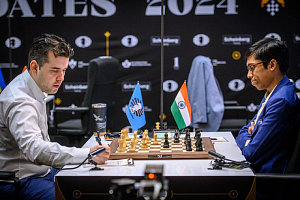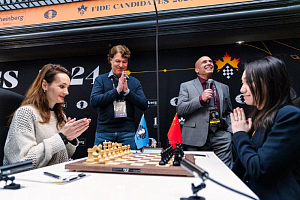Candidates’ Prowess
Day one of the Tal Memorial. Report by Eteri Kublashvili
Most looked forward to battles of the beloved Tal Memorial have at last started in Moscow. As is well known, the event takes place in the Museum of Russian Impressionism, which I whole-heartedly advise to visit: this is a modern building equipped with infrastructure suitable for various needs of visitors. However, the main aspect of each museum is its collection of works. Thus, crowds of people of all ages (it is beyond imagination we are going to be up against this weekend!) come here every day to see the canvases of artists, the majority of whom were born in the mid to late 19th century. We talk about Grabar, Kustodiev, Konchalovsky, Serov, Petrov-Vodkin, and a number of other outstanding masters.
Now, one of the most interesting exhibition titled “Wives” is on the display in the Museum. The exposition shows portraits of wives, beloved girls, families of various artists, including those of Ilya Repin, Mikhail Vrubel, Alexander Deineka. As is written on the Museum’s website, the exposition “is designed to show how the Russian art developed from the end of the 19th to the middle of the 20th century through the prism of portraits of the great painters’ wives." Here you can see the society trended towards feminization, and this topic is more relevant than ever in the light of never ending scandals around the likes of Weinstein. The exhibition is scheduled until mid May. Come yourselves and bring your children with you and you will never regret the time spent here.
Now let us gradually move from fine arts to that of chess. Our super grandmasters perform in a small enclosed space against the background of vivid Impressionist paintings. The spectating audience watch their game with great interest and take pictures on their mobile devices, without crossing the border lines. When in the lobby, the Tal Memorial participants are literally hunted down by chess fans to take pictures and autographs.
Sergey Shipov comments from the spacious press center, where quite a number of people (especially towards the evening) come to listen to the famous grandmaster, and even enter into a discussion with him or discuss the issues that interest them during the breaks. The English broadcast is served by no less starry commentators - Evgeny Miroshnichenko and Alexander Morozevich.
After day one, with three rounds behind, the lead was taken by Shakhriyar Mamedyarov - one of the participants of the Candidates tournament who has come to Moscow to warm up for the round-robin of the year. Shakhriyar was already a winner the Tal Memorial, when the supertournament was held to a blitz format in Sochi.
In round one, Shakh’s rival was yet another participant of the upcoming Berlin battle - Vladimir Kramnik. Their opposite castled kings turned the game into a very sharp one: Shakhriyar launched a pawn offensive on the kingside, but Vladimir succeeded with his counterplay on the queenside. At one point Black offered a pawn sacrifice, but it was not accepted; following a trade of queens the position equalized, and the opponents agreed to a draw.
However, there was no stopping Shakhriyar in the following two encounters. In round two, playing White against Peter Svidler, Shakh launched an early offensive against the opponent’s king even without having castled himself.
Mamedyarov – Svidler

Black’s position rings alarms, and Mamedyarov is quick to mobilize his last dormant reserves - 17. 0-0-0. Black, in turn, makes up his mind to buttress his centralized knight via 17…f5?, but it only resulted in more holes gaping around own king.
18. Nxe4 fxe4 19. Ne5 Rf6 20. Qg4
The engine believes 20…Qa5 to be the lesser of evils, resigning oneself to a loss of exchange after 21. Nd7. Frankly speaking, this is not something to relish!
20…Nf8 21. Bh6 Bxh6+ 22. Rxh6 Qc8, and Black resigned without waiting for his opponent’s 23.Qh4 with an inevitable checkmate.
Mamedyarov's opponent in game three was Viswanathan Anand. The Azeri grandmaster, playing Black, opted for the not-so-popular line of the French Winawer, outwitting his opponent somewhere to get a very pleasant ending. White made up his mind to give up a pawn to activate his rooks, but his counterplay proved insufficient. Shakhriyar was precise and tough in his performance, converting his edge without fail.
Trailing a half point behind the leader are Alexander Grischuk, Viswanathan Anand and Hikaru Nakamura.
Grischuk made two draws - with Sergey Karjakin in round one and with Boris Gelfand in round three. And it was a victory over Vladimir Kramnik in between. The 14th world champion won a pawn in the course of a viscous maneuvering struggle, but then simply blundered a piece with only seconds on his clock.
Hikaru Nakamura started off with a victory over Boris Gelfand. According to Sergey Shipov, it was round one’s most interesting game, and it is hard not to agree with him. There arose a very sharp position from the anti-Moscow gambit, where Black uncorked a novelty on move 14 and got a piece for three pawns. The extravaganza lasted until the trade of queens, upon which a time of technical conversion arrived: White won another pawn and started promoting his passers on both flanks.
Nakamura – Gelfand

32. h4! Bd4
Black is ready to give back material so as not to hunker down full-time.
33. Rd1 Nxg3+ 34. Rxg3 Bxe5 35. Rxd7 Bxg3 36. Rd4 Rxh4+ 37. Rxh4 Bxh4 38. Nxf7, and Nakamura went on to convert his material edge.
Round two paired Nakamura against Daniil Dubov. In the opening the American grandmaster was seen either casting glances upwards towards the ceiling or frowning, which clearly indicated that the opponent’s opening choice (1. c4 Nf6 2. Nc3 e6 3. e4!) made him frantically search through his mental megabase. Daniil did not shy from sacrificing two pawns, then yet another one, to leave the opponent’s king uncastled. There arose a very offbeat setup in which the white queen was opposed by the opponent’s pair of rooks and pawns.
Dubov – Nakamura

19. Rd1! fxe5 20. Nxe5 Bf5 21. Rxd6 cxd6 22. Nd7+ Kf7 23. Qc4+ Be6 24. Qf4+ Nf5 25. g4 Rad8?!

The engine prefers 25…c2! The white knight is bogged down on d7 anyway, whereas the black passer is extremely dangerous. When White takes the f5-knight, the combination of these factors provides for a dynamic balance in the position.
And then, after the swap of knights, the events developed swiftly, which was in no lesser degree promoted by a dramatic decrease of time on the clock. Daniil managed to force the black king of into a dangerous voyage into almost as far as the center of the board, winning the c-pawn and disconnecting enemy’s pieces. While pondering his way out of these misfortunes, Nakamura ended up losing on time. It was, however, in an absolutely hopeless position already.
However, in game three Hikaru seemed none the worse and defeated Ian Nepomniachtchi, who, according to Sergey Shipov, acted as if he were still on the wave of playing blitz. The thing is, the day before the Tal Memorial Ian brilliantly won the Region Group of Companies Cup and carried his lightning speed over into our tournament. Black played very fast, but could not create significant counterplay in a non-standard type of the King’s Indian Defense. Nakamura celebrated victory on move 38.
The third “pursuer” - Viswanathan Anand - started the tournament with a victory over Daniil Dubov. In the middlegame of the Sicilian Rossolimo, Black lost a pawn, and even the advantage of a pair of bishops over a pair of knights did not help him to bail out. Anand’s conversion was precise.
In round two Anand outplayed Ian Nepomniachtchi. In the final stage of the game Ian blundered when choosing between two possible pawn takes.
Nepomniachtchi – Anand

48. Kxb6?
Balance was maintained by 48. Kxd6, whereas in the game after 48…g5 White could no longer advance 49. с5 in view of 49…Rxb4+.
49. Kc6 g4 50. b5 h4 51. b6 h3 52. b7 Rf8 53. Kxd6 h2 54. Rc1 g3 55. Rh1 Kg5 0-1.
In the 50% zone are Daniil Dubov (who drew Sergey Karjakin in round three while down a pawn in the ending), Sergey Karjakin (with three draws) and Vladimir Kramnik.
Having started with a defeat and a draw, the 14th world champion defeated Peter Svidler as Black in round three. Not only did Black successfully solve his opening problems in the King’s Indian Defence, he also obtained a very promising position. White sacrificed a pawn, but it only added to his problems. Black’s pieces invaded the opponent’s camp, and the former world champion confidently converted his edge.
Boris Gelfand stands -1 at the moment. The Israeli grandmaster followed his loss to Nakamura with draws against Sergey Karjakin and Alexander Grischuk.
Day one has not gone well for Ian Nepomniachtchi and Peter Svidler, who have half a point under their belts. Still, there are six interesting rounds ahead yet, which we are looking forward to with enthusiasm.
By the way, in the blitz tournament, scheduled to take place in the Central Chess Club on March 5, the participants of the rapid section will be added by Alexander Morozevich, Dmitry Andreikin, Vladimir Fedoseev and Vladislav Artemiev.





















